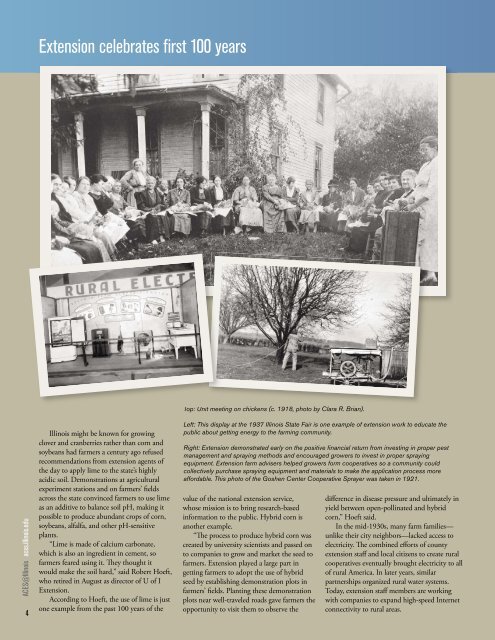t7W0J
t7W0J
t7W0J
Create successful ePaper yourself
Turn your PDF publications into a flip-book with our unique Google optimized e-Paper software.
Extension celebrates first 100 yearsTop: Unit meeting on chickens (c. 1918, photo by Clara R. Brian).ACES@Illinois aces.illinois.edu4Illinois might be known for growingclover and cranberries rather than corn andsoybeans had farmers a century ago refusedrecommendations from extension agents ofthe day to apply lime to the state’s highlyacidic soil. Demonstrations at agriculturalexperiment stations and on farmers’ fieldsacross the state convinced farmers to use limeas an additive to balance soil pH, making itpossible to produce abundant crops of corn,soybeans, alfalfa, and other pH-sensitiveplants.“Lime is made of calcium carbonate,which is also an ingredient in cement, sofarmers feared using it. They thought itwould make the soil hard,” said Robert Hoeft,who retired in August as director of U of IExtension.According to Hoeft, the use of lime is justone example from the past 100 years of theLeft: This display at the 1937 Illinois State Fair is one example of extension work to educate thepublic about getting energy to the farming community.Right: Extension demonstrated early on the positive financial return from investing in proper pestmanagement and spraying methods and encouraged growers to invest in proper sprayingequipment. Extension farm advisers helped growers form cooperatives so a community couldcollectively purchase spraying equipment and materials to make the application process moreaffordable. This photo of the Goshen Center Cooperative Sprayer was taken in 1921.value of the national extension service,whose mission is to bring research-basedinformation to the public. Hybrid corn isanother example.“The process to produce hybrid corn wascreated by university scientists and passed onto companies to grow and market the seed tofarmers. Extension played a large part ingetting farmers to adopt the use of hybridseed by establishing demonstration plots infarmers’ fields. Planting these demonstrationplots near well-traveled roads gave farmers theopportunity to visit them to observe thedifference in disease pressure and ultimately inyield between open-pollinated and hybridcorn,” Hoeft said.In the mid-1930s, many farm families—unlike their city neighbors—lacked access toelectricity. The combined efforts of countyextension staff and local citizens to create ruralcooperatives eventually brought electricity to allof rural America. In later years, similarpartnerships organized rural water systems.Today, extension staff members are workingwith companies to expand high-speed Internetconnectivity to rural areas.


